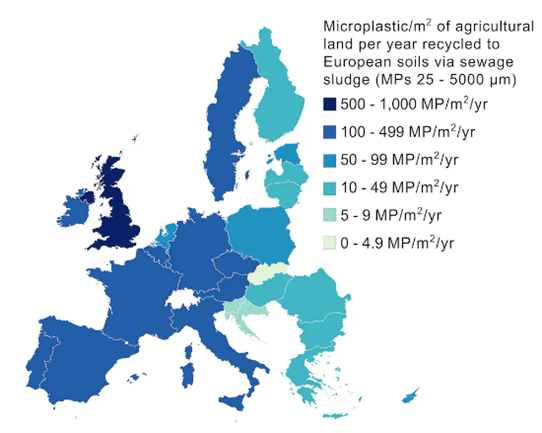Find out more about The Open University's Environment qualifications.
Microplastics are small - less than 5 millimetres in size - plastic particles that come from various sources. They can either be intentionally manufactured, known as primary microplastics, or the result of the degradation of larger plastic items, called secondary microplastics. Primary microplastics include microbeads in personal care products and industrial pellets, while secondary microplastics arise from the breakdown of plastic bottles, bags, and packaging materials.
How do microplastics end up in our food?
Microplastics find their way into the food chain through a complex web of pathways. While microplastics' presence in the oceans is well known, their infiltration into another crucial ecosystem - soil - poses additional concerns. Microplastics can find their way into soil through various routes, including the application of sewage sludge, irrigation with contaminated water, and the decomposition of plastic mulch used in agriculture. Once in the soil these tiny particles interact with plant roots, soil organisms, and the broader ecosystem.
 Sources of microplastics in soil.
Sources of microplastics in soil.
The presence of microplastics in the ground has an impact on
soil health and plants, disrupting the delicate balance and functioning of this
vital ecosystem. Microplastics can hinder water retention, alter soil
structure, and impede nutrient cycling. Plants can absorb microplastics from
the soil through their roots. The presence of microplastics in soil can affect
the activity and diversity of soil microorganisms, which play a crucial role in
maintaining soil fertility and supporting plant growth.
The direct effects on plant health and productivity are still being studied, we are yet to know whether microplastics are entering our food chain by accumulating in edible parts of plants. The transfer of microplastics from soil to crops raises questions about the long term consequences for human health.
How do microplastics enter the soil?
One of the ways that microplastics get into soil is through the use of sewage sludge as fertilizer. A study conducted by Lofty and colleagues showed that across Europe the UK had the highest amount of microplastic pollution within its soils. The study found that between 500 and 1000 microplastic particles are applied to each square metre of agricultural land in the UK every year.
 A map showing the relative MP pressure on European agricultural soils, per nation, caused by recycling MP-laden sewage sludge, expressed as MPp/m2/yr. From Lofty et al 2022.
A map showing the relative MP pressure on European agricultural soils, per nation, caused by recycling MP-laden sewage sludge, expressed as MPp/m2/yr. From Lofty et al 2022.
Recognising that sewage sludge application introduces
microplastics into soil is crucial when addressing microplastic pollution. To
mitigate the potential risks associated with microplastics from sewage sludge
we need to focus on advanced treatment processes, explore alternative waste
management options, and enact appropriate regulations. This will result in sustainable
and responsible practices which protect the integrity of our soils and
ecosystems, ensuring a healthier future for all.
What can be done to protect agricultural soil from microplastics?
There are several ways in which we can protect agricultural soil from microplastics. One method is to reduce the use of plastic in agriculture. This includes reducing the use of plastic mulch, seed coatings, and other agricultural plastics. This could be supported by improving the management of agricultural plastics. This includes collecting and recycling agricultural plastics whenever possible and disposing of them properly when they cannot be recycled. Another step could be to use biodegradable agricultural plastics which break down over time, helping to reduce microplastic pollution.
Wastewater companies which produce sewage sludge could treat wastewater before it is used as a fertilizer for agricultural soil. Regulators could promote the monitoring of microplastic levels in agricultural soil, identifying areas where microplastic pollution is high and developing strategies to reduce it. By taking these steps, farmers and other stakeholders can help to protect agricultural soil from microplastic pollution, ensuring a safe and sustainable food supply for future generations.







Rate and Review
Rate this article
Review this article
Log into OpenLearn to leave reviews and join in the conversation.
Article reviews